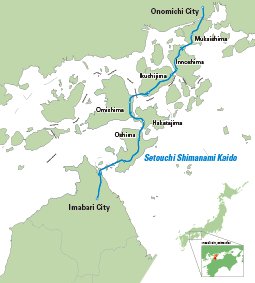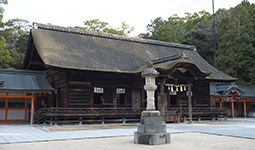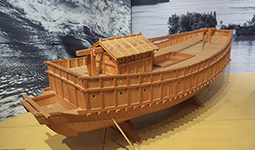Home > Highlighting JAPAN > Highlighting Japan March 2017 > Japan Heritage
Highlighting JAPAN
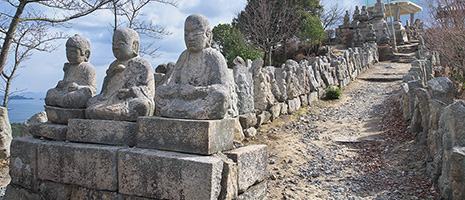
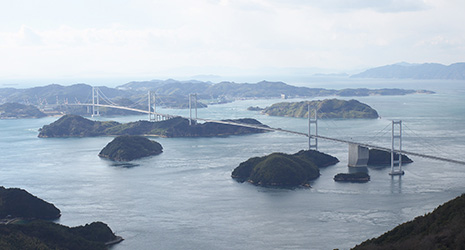
- PREVIOUS
- NEXT
The Murakami Kaizoku of the Seto Inland Sea
Benevolent seafarers the Murakami Kaizoku have left their mark on the Geiyo Islands.
The Seto Inland Sea separates three of the Japanese archipelago’s four main islands, Honshu, Shikoku and Kyushu, and is itself dotted with some 700 islands large and small. Extending from North to South near the center of the Seto Inland Sea are the Geiyo Islands. The distance between each of these islands is very short, and because the waters of the Seto Inland Sea are shallow, the currents here run perilously fast.
“The Geiyo Islands were a well known meeting place in this dangerous sea even in ancient times,” says Ken Tanaka of the Murakami Suigun Museum (“suigun” means “feudal navies” [such as the Murakami Kaizoku]), which is located on the “big island” of Oshima off Imabari in Ehime Prefecture. “Exploiting its knowledge of the characteristics of the Seto Inland Sea, the Murakami Kaizoku controlled the east-west sea route during the sixteenth century.”
From around the middle of the fourteenth century to the fifteenth century, the Murakami Kaizoku protected the ships including those of the Muromachi feudal government (the shogunate of 1336 to 1573) passing through the Seto Inland Sea. Over time, the Murakami Clan took control of the major sea routes and ports using their knowledge and expertise navigating the rapid currents and narrow straits, and adopted the Geiyo Islands as their base.
The Murakami Clan typically piloted ships through the Seto Inland Sea by issuing them a flag as a “passport” or by boarding the vessels in return for a fee. In this way the Murakami Clan also protected the sea traffic from pirates and from the perils of the strong currents.
“Although the word kaizoku means ‘pirate,’ the Murakami Kaizoku were different from the traditional image of western pirates or from present-day pirates who unlawfully board ships and forcefully collect money or seize goods. The Murakami Kaizoku helped to maintain order in the sea by assuring the security of ships,” says Tanaka. “In addition, whereas pirates have a cut-throat image, the kaizoku of the Murakami Clan were religious and enjoyed cultural activities such as the tea ceremony and renga collaborative poetry.”
The activities of the Murakami Kaizoku ceased at the end of the sixteenth century with the piracy banning order issued by Hideyoshi Toyotomi (1537–1598), who reigned over Japan at that time, but the cultural heritage of the Murakami Kaizoku is still very much in evidence on the Geiyo Islands.
On Oshima, the Murakami Suigun Museum exhibits a range of items associated with the Murakami Clan such as weapons, armor and ancient writings, as well as scale models of boats from the period. A sightseeing boat departs from a dock near the museum taking passengers across the strait and past numerous islands, including Noshima, location of the Murakami Clan castle. The boat navigates the same violently swirling current that the Murakami Kaizoku mastered centuries ago. Every July, immediately in front of the museum, crews of twelve race reconstructed rowing boats from the period, which are maneuvered from a standing position, in the Murakami Suigun Boat Race.
Oyamazumi-jinja shrine on the island of Omishima is where the military commanders of the Murakami Clan prayed to the gods for good fortune in war and for the safety of the vessels passing through the Inland Sea. Giant camphor trees stand guard on the grounds, and the shrine’s magnificent treasure hall exhibits weapons and armor reportedly offered by famous lords and military commanders.
On Mt. Shirataki on Innoshima Island, a part of Onomichi in Hiroshima Prefecture, the head of the Murakami Clan reportedly constructed a temple in the sixteenth century. In the nineteenth century, a new religion leader and his followers on the island carved approximately 700 stone statues of Buddha and placed them along the path at the top of the mountain. The expression on each statue’s face is unique. From the top of Mt. Shirataki, visitors can enjoy spectacular views of the Seto Inland Sea.
“On the Geiyo Islands, you can experience scenery and history through each of your five senses,” says Tanaka. “We will discover more about the Murakami Kaizoku as archaeological investigations continue. I would like to spread the word “kaizoku” to the world so that it becomes as familiar as “ninja” and “samurai.”
- PREVIOUS
- NEXT
© 2009 Cabinet Office, Government of Japan
